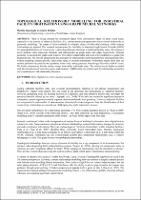Chapter Topological Relationship Modelling for Industrial Facility Digitisation Using Graph Neural Networks
Author(s)
Jayasinghe, Haritha
Brilakis, Ioannis
Language
EnglishAbstract
There is rising demand for automated digital twin construction based on point cloud scans, especially in the domain of industrial facilities. Yet, current automation approaches focus almost exclusively on geometric modelling. The output of these methods is a disjoint cluster of individual elements, while element relationships are ignored. This research demonstrates the feasibility of adopting Graph Neural Networks (GNN) for automated detection of connectivity relationships between elements in industrial facility scans. We propose a novel method which represents elements and relationships as graph nodes and edges respectively. Element geometry is encoded into graph node features. This allows relationship inference to be modelled as a graph link prediction task. We thereby demonstrate that connectivity relationships can be learned from existing design files, without requiring domain specific, hand-coded rules, or manual annotations. Preliminary results show that our method performs successfully on a synthetic point cloud testset generated from design files with a 0.64 F1 score. We further demonstrate that the method adapts to occluded real-world scans. The method can be further extended with the introduction of more descriptive node features. Additionally, we present tools for relationship annotation and visualisation to aid relationship detection
Keywords
BIM; Digital twin; GNN; machine learningDOI
10.36253/979-12-215-0289-3.88ISBN
9791221502893, 9791221502893Publisher
Firenze University PressPublisher website
https://www.fupress.com/Publication date and place
Florence, 2023Series
Proceedings e report, 137Classification
Virtualization


 Download
Download Web Shop
Web Shop